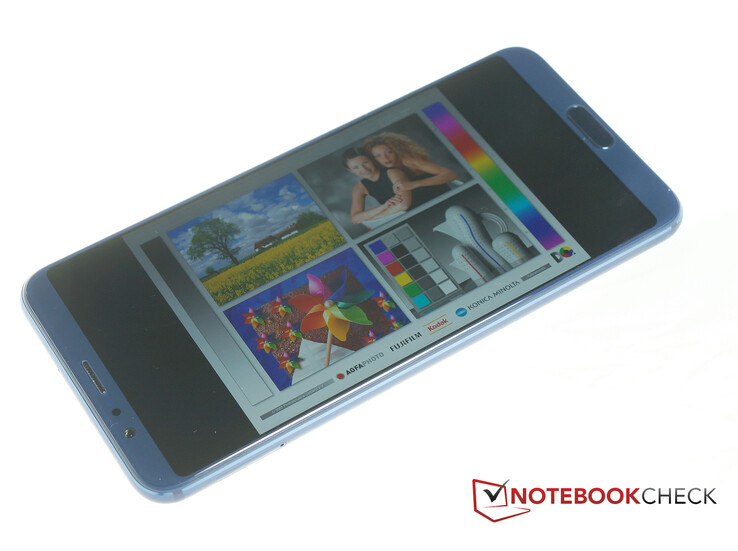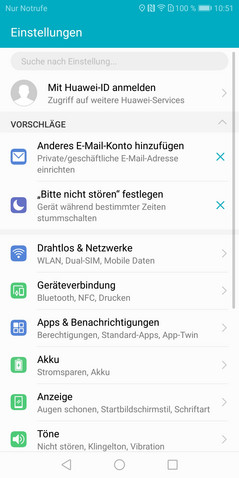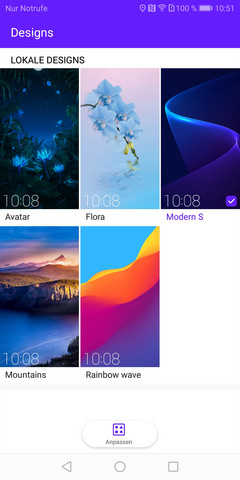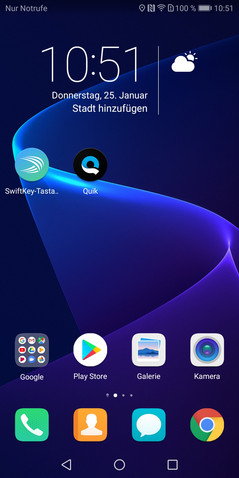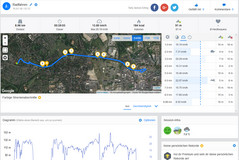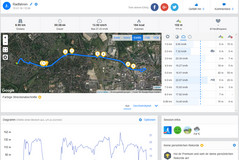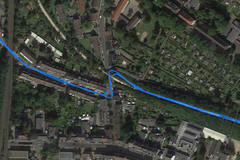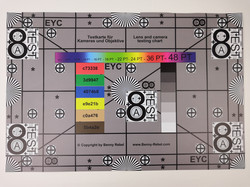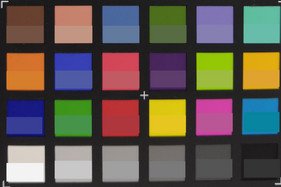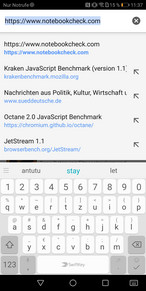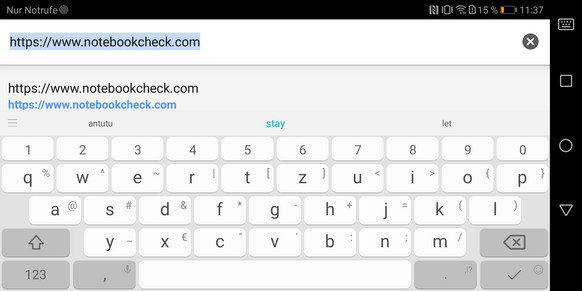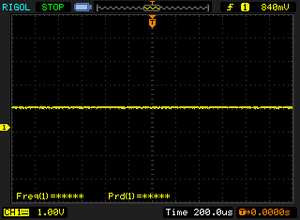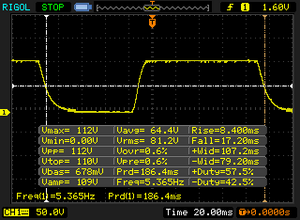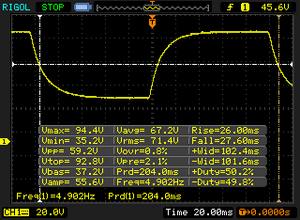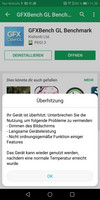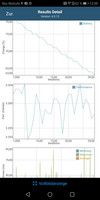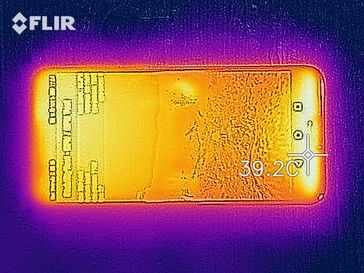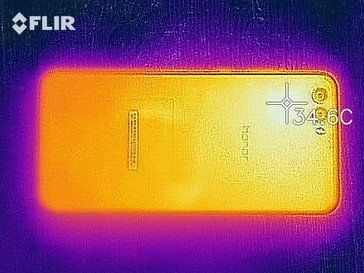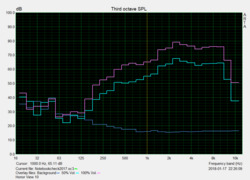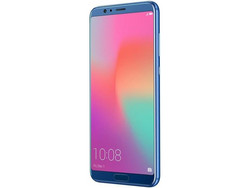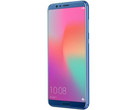Honor View 10 Smartphone Review
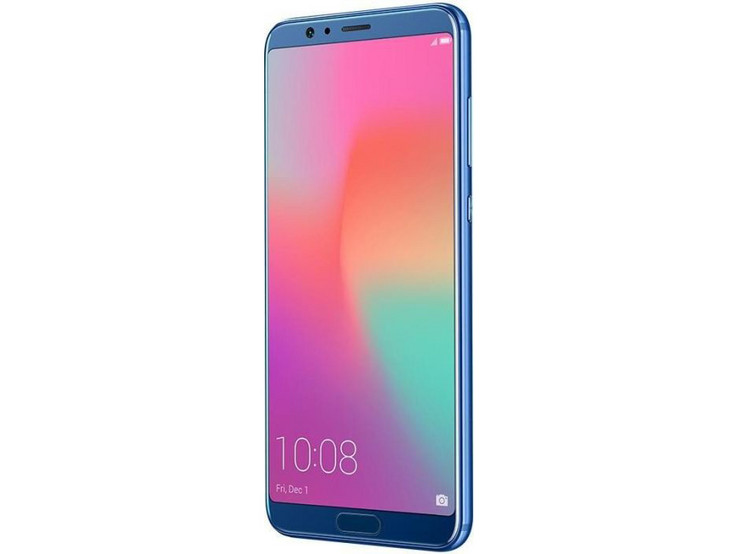
When Honor presents a new top-range device, its competition takes a very close look: After all, Huawei's direct marketing brand is known for offering price-breaking devices, usually of very good quality. The Honor View 10 (or Honor V10) was presented in China in November last year and is a slightly trimmed-down version of the Huawei Mate 10. Its price is significantly lower at £500, but it cannot entirely keep up with the Mate 10 in all respects, for example the camera and Wi-Fi modem. There are some design differences as well - but do these differences have serious consequences or are they mere trifles?
Please note: This device is not available in the US at the time of writing.
In Europe, we can only get the Huawei Mate 10 Pro, so today's device will also have to compete against this model in our comparison. Other devices that we have included: The (also very affordable) OnePlus 5T that made a good impression on us while testing, and the LG V30 that does not only have a similar name, but also a similar concept to our Honor View 10. The Sony Xperia XZ Premium, the Apple iPhone 8 Plus and the Samsung Galaxy S8 Plus are currently some of the most important flagship devices, and are ready to compete against the View 10.
Case
More and more smartphone manufacturers are changing from the well-known 16:9 format to a 2:1 format. This does not make a big difference, but does mean that the smartphones are a little taller and/or narrower. One of the main reasons for this change is that it is supposed to make even large screens easier to use with one hand - plus the narrow, long design looks more trendy and modern.
Still, Honor has placed the fingerprint sensor on the front, below the screen, while other manufacturers such as OnePlus have changed to putting their sensor at the back of their smartphones. The Huawei Mate 10 Pro also has a fingerprint reader placed at the back, so the two devices already have different looks. In addition, they have different camera designs; we are not overly impressed by the Honor View 10's version: The two dual-camera lenses stand out of the case separately and are rather close together - the Huawei Mate 10 Pro's lenses look more elegant and are placed in a stripe that sets itself off from the rest of the surface. The lenses of the Huawei Mate 10 Pro are also positioned further down, which limits the risk of fingers being in the way when taking a picture.
The available colors are different too: While the Honor View 10 is available in black and blue, the Huawei Mate 10 Pro offers either a gray, brown or blue case. The back of the Honor View 10 is made of matte metal. While this cannot create the wow-effect of the Honor 8 with its brilliant reflective back, for example, the Honor is easy to keep clean. The device is quite resistant to pressure and can only be warped minimally, at which point it produces low creaking sounds. The View 10 has a weight of 172 grams (~ 6 oz), which is average for a smartphone. It is significantly nicer to hold than, say, the iPhone 8 Plus at over 200 grams (~ 7 oz). Honor has decided against an IP certification, so you should not let the device fall into water.
Connectivity
For £500, the Honor View 10 gets you 128 GB of storage space and 6 GB of memory. No other configurations are currently available. The storage device is actually a fast UFS 2.1 storage, which has become a standard for top-range devices. But many models still have 64 GB of storage - the Samsung Galaxy S8 Plus or the LG V30, for example. You can expand storage via a microSD card by up to 256 GB, but have to give up one of the two SIM slots in exchange. By the way, the Honor View 10 supports simultaneous LTE access with both SIM cards.
The working memory is not as generous as that of the OnePlus 5T (8 GB), but the Samsung Galaxy S8 Plus and the LG V30 both make do with 4 GB. You will probably only notice a difference in everyday use when you have a lot of apps open simultaneously. The USB-C port only supports USB 2.0 speeds; external devices can exchange data or be charged via USB-OTG. A particular specialty that Honor has given its flagship phone is its infrared sensor, with which you can control your TV, for example.
Software
Our test unit comes installed with Android 8.0 and its security patches are somewhat out of date - from November 6, 2017. On top of that, Huawei, or rather Honor, has added its own EMUI interface, which makes only a few changes to the normal Android navigation. The interface brings a lot of additional software as well as some advertising links in the "top apps" folder. The phone also has some Free2Play games on it, which you could also simply download from the Google Play store if you wanted them.
Huawei has installed several functions that use the NPU (Neural Processing Unit) of the SoC and work like artificial intelligence. The app "Translator" uses machine learning to suggest translations and actually comes from Microsoft. The artificial intelligence is also supposed to optimize processes on the smartphone, thereby ensuring that it continues to run smoothly.
Honor has also installed some useful apps, such as a file manager, the app "Designs", with which you can change the appearance of the interface, or the telephone manager that cleans up data and scans for viruses. There are also some smaller tools including a mirror that uses the front camera, or an app that activates the LED flash like a flashlight. In short, you will have to do a bit of tidying-up if you prefer a simple system.
Communication and GPS
Huawei has included a very fast LTE modem in the Honor View 10 that enables download speeds of up to 1.2 GHz. At least in theory - of course your network provider has to support these speeds as well, and most are not there yet. Our test unit supports a few LTE bands less than the Huawei Mate 10 Pro, but Europe is still covered. Reception is good - even indoors in the city we had at least half the available signal strength. We used the well-developed German D2 network for our test.
The Wi-Fi signal supports all current standards - 802.11 a/b/g/n/ac. However, the speed is rather low in our standardized test with our reference router Linksys EA8500: The Huawei Mate 10 Pro already had disappointingly slow Wi-Fi speeds, but the Honor View 10 is even slower. Other high-end smartphones offer up to three times the speed. In our practical test, the pages still load quite quickly; after all, the maximum transfer speed of our reference test is still a lot higher than the speed of our internet connection. The signal is at maximum close to the router and drops to half at a distance of 10 meters (~11 yd) and through three walls, but pages load just as quickly as they did when we were near the router.
The smartphone cannot locate us indoors, even near the window. It still takes quite a while for the phone to find us outdoors, and even then it can only locate us within 13 meters (~14 yd). Positioning is rather imprecise in Google Maps as well, but at least the compass works reliably.
But what about when the Honor View 10 is used for navigating or recording routes? We took the device on a bike ride and used the app Runtastic to record the route. We also packed our professional navigator Garmin Edge 500. There is a difference of only 10 meters (~11 yd) on our measured routes, which is a good sign. The Honor View 10 also places us almost exactly on the used paths, although it thought we were next to the actual road during the bend. Our test unit is even closer than the Garmin Edge 500 in some areas. Due to the imprecise positioning, we would still only recommend you to use the smartphone for navigating occasionally.
Telephone and Call Quality
The handling of Huawei's telephone app is very similar to that of Google's original, but it looks a little different and also has some additional features. For example, you can accept or decline calls with voice commands (in English).
The overall voice quality is average. Both headphones and speakers do not reproduce the caller's voice as well as we would have wished for. The microphone transmits not only our voice, but also other noises and the sound is not clear.
Cameras
The back of the Honor View 10 features a dual camera whose main sensor records in 16 MP, which is higher than the module on the Huawei Mate 10 Pro. However, this camera cannot boast Leica branding. Like Huawei's flagship phone, the second sensor is a 20-MP, monochrome sensor. The information from both sensors is combined when the lighting is bad, which is supposed to create better images. The View 10 does not have an optical image stabilizer and its aperture of f/1.8 is a little lower. The camera offers a wide range of modes: You can take black-and-white pictures with the dedicated sensor, and there is an AR camera that can, for example, add cat ears to faces. In professional mode, you can adjust a lot of parameters yourself, and in portrait mode, the software calculates the blur in the background. Artist mode, lets you use countless filters and there is also a separate mode for tracing light trails at night.
The photos basically have good lighting and relatively warm colors. Compared to the camera of the iPhone X, the images appear less detailed and Apple's flagship phone brightens everything up even better. In good lighting, the Honor View 10 can take good and sharp pictures, but we still like the camera of the OnePlus 5T a little better, as its pictures are also brighter and sharper. Compared to the Huawei Mate 10 Pro, we would say that the View 10's image quality is not quite as good, but you can only tell a difference if you look very closely, for example at the writing on our rabbit's t-shirt.
In video mode, you can record 4K videos with 30 FPS and Full-HD videos in 60 FPS. The quality is quite good, although the colors appear a little poor and low lighting quickly creates image noise. Details are displayed nicely; the light sensor reacts quickly and precisely to changes in the lighting.
There is a 13-MP camera with fixed focus at the front. This camera also has a higher resolution than that of the Huawei Mate 10 Pro. The images appear less detailed and offer good color reproduction, but they could be a bit brighter.
All cameras are supported by the installed artificial intelligence processor, which recognizes different types of objects and movements in the image and automatically adapts camera settings.
The main camera also had to prove itself in our lab under controlled lighting conditions. Here, we noticed double contours on writing and some blurriness at the edges. The image was very sharp in other areas, colors and color transitions are a little pixelated.
Accessories and Warranty
Huawei supplies a good selection of accessories with its View 10: You will receive a quick-charge device with a USB cable, and a transparent bumper for the smartphone that protects it from shocks and damages. The manufacturer has also included an in-ear headset. There are no other accessories specific to the V10 on the online store.
Honor offers 24 months of warranty for its smartphones. Please see our Guarantees, Return Policies and Warranties FAQ for country-specific information.
Input Devices & Handling
Huawei has chosen SwiftKey as its keyboard app. This is the only installed keyboard, but you can easily install a different keyboard if you want to. SwiftKey offers large keys and typing is reliable. There are numerous themes with which you can adapt the keyboard, as well as many other options such as multi-lingual use, change of size, gesture input, etc.
The touchscreen is very sensitive and precise even at the edges. A glove mode with particularly high sensitivity is available for winter. The standby button on the right side of the device is slightly grooved, which makes it easy to find. Above it you will find the volume rocker; we would have liked for its two pressure points to be more clearly distinguishable.
The fingerprint reader works very reliably and quickly and also wakes the phone from standby. If you like, you can also use your fingerprint for navigating through the menus. The very precise and intuitive control can replace navigating through the menu on the screen.
If you would like to try out more alternative navigation options, you can set the phone to silent by turning it over, draw letters on the screen to open apps and use HiVoice, for built-in voice recognition.
The Honor View 10 can also be unlocked with face recognition, but this only works by comparing your face with a saved image of yourself, so photos or masks can also be used to unlock the phone. This method should not be the only method you use to unlock your phone if you store sensitive data on your smartphone. In our test, we had an issue with taking the reference photo. The device took the photo without prior warning and we had to retry several times in order to get a sharp, well-positioned photo that the smartphone could use to recognize our face. Even with this image, unlocking was not always very reliable, and you can store only one face.
Display
A maximum brightness of 523 cd/m² is average for an IPS screen. While the Honor View 10 can be quite bright when you need it to, it is not quite as bright as that of many competitors. And you can only reach this brightness with the brightness sensor activated - if you set it to maximum brightness manually, the display only reaches 477 cd/m². The standard resolution in top-range smartphones has settled to 2160x1080, although some devices such as the Sony Xperia XZ Premium or the Samsung Galaxy S8 Plus also offer higher resolutions. The brightness distribution of 88% is not quite as even as those of most comparison devices, but with the naked eye you will at most notice slight differences in brightness on large areas of color.
| |||||||||||||||||||||||||
Brightness Distribution: 88 %
Center on Battery: 530 cd/m²
Contrast: 1514:1 (Black: 0.35 cd/m²)
ΔE ColorChecker Calman: 2.4 | ∀{0.5-29.43 Ø4.77}
ΔE Greyscale Calman: 2.2 | ∀{0.09-98 Ø5}
Gamma: 2.25
CCT: 6598 K
| Honor View 10 IPS, 2160x1080, 6" | Huawei Mate 10 Pro OLED, 2160x1080, 6" | OnePlus 5T AMOLED, 2160x1080, 6" | Sony Xperia XZ Premium IPS, 3840x2160, 5.5" | Samsung Galaxy S8 Plus Super AMOLED, 2960x1440, 6.2" | Apple iPhone 8 Plus IPS, 1920x1080, 5.5" | LG V30 OLED, 2880x1440, 6" | |
|---|---|---|---|---|---|---|---|
| Screen | 17% | 0% | -16% | 19% | 14% | -51% | |
| Brightness middle (cd/m²) | 530 | 629 19% | 425 -20% | 578 9% | 560 6% | 559 5% | 432 -18% |
| Brightness (cd/m²) | 523 | 636 22% | 423 -19% | 568 9% | 562 7% | 538 3% | 428 -18% |
| Brightness Distribution (%) | 88 | 94 7% | 92 5% | 92 5% | 93 6% | 90 2% | 87 -1% |
| Black Level * (cd/m²) | 0.35 | 0.62 -77% | 0.38 -9% | ||||
| Contrast (:1) | 1514 | 932 -38% | 1471 -3% | ||||
| Colorchecker dE 2000 * | 2.4 | 1.7 29% | 2.1 12% | 2.8 -17% | 1.7 29% | 1.3 46% | 4.18 -74% |
| Colorchecker dE 2000 max. * | 5.5 | 3.6 35% | 3.4 38% | 5.1 7% | 3.4 38% | 2.7 51% | 8.53 -55% |
| Greyscale dE 2000 * | 2.2 | 2.4 -9% | 2.5 -14% | 2.8 -27% | 1.6 27% | 1.8 18% | 5.3 -141% |
| Gamma | 2.25 98% | 2.15 102% | 2.32 95% | 2.15 102% | 2.13 103% | 2.25 98% | 2.33 94% |
| CCT | 6598 99% | 6337 103% | 6455 101% | 6728 97% | 6435 101% | 6797 96% | 7487 87% |
| Color Space (Percent of AdobeRGB 1998) (%) | 81.57 | ||||||
| Color Space (Percent of sRGB) (%) | 99.87 |
* ... smaller is better
Screen Flickering / PWM (Pulse-Width Modulation)
| Screen flickering / PWM not detected | |||
In comparison: 53 % of all tested devices do not use PWM to dim the display. If PWM was detected, an average of 8088 (minimum: 5 - maximum: 343500) Hz was measured. | |||
Black areas are still 0.35 cd/m² bright. This is a good value, although it clearly cannot keep up with OLED display, which has an absolute black value. Dark areas appear deep and uniform and colors appear strong. The contrast ratio is good at 1514:1. The white balance can be adjusted with various presets or completely manually. You can also choose between normal or vivid colors. The settings also offer a blue-light filter. We did not measure any screen flickering.
We tried to take a look at as many presets as possible during our measurements with the spectrophotometer and the CalMAN software. To get the best appearance, we would recommend setting the device to normal colors with the white balance preset "warm". This way, you will not see any blue cast. Vivid colors and the standard white balance produce a strong blue cast. The color-space coverage is good; the color space sRGB is covered almost completely.
Display Response Times
| ↔ Response Time Black to White | ||
|---|---|---|
| 25.6 ms ... rise ↗ and fall ↘ combined | ↗ 8.4 ms rise | |
| ↘ 17.2 ms fall | ||
| The screen shows relatively slow response rates in our tests and may be too slow for gamers. In comparison, all tested devices range from 0.1 (minimum) to 240 (maximum) ms. » 60 % of all devices are better. This means that the measured response time is worse than the average of all tested devices (20.2 ms). | ||
| ↔ Response Time 50% Grey to 80% Grey | ||
| 53.6 ms ... rise ↗ and fall ↘ combined | ↗ 26 ms rise | |
| ↘ 27.6 ms fall | ||
| The screen shows slow response rates in our tests and will be unsatisfactory for gamers. In comparison, all tested devices range from 0.165 (minimum) to 636 (maximum) ms. » 90 % of all devices are better. This means that the measured response time is worse than the average of all tested devices (31.6 ms). | ||
The Honor View 10 can be used outdoors. Ideally, you would have the brightness sensor turned on in order to reach the maximum brightness. The sensor reacts quickly and reliably. There are slight differences in brightness from various viewing angles, but the colors remain good and the content can be read easily, even from very wide angles.
Performance
The HiSilicon Kirin 970 SoC is also used in the Huawei Mate 10 Pro and is very powerful with its eight cores and a clock rate of up to 2.4 GHz. The SoC offers similar results in the Honor View 10 as it did in the Huawei Mate 10 Pro, and can also keep up well with other Android comparison devices. Only the Apple iPhone 8 Plus performs even better. So we really do get high-end performance with the Honor View 10, both in terms of the menu and apps and graphics performance. Some graphics benchmarks, however, showed significantly lower results as in the Apple iPhone 8 Plus. This could be connected to the temperature issues that we will talk about in the "Temperature" section.
The SoC has an NPU - a neural processor that deals with calculations for the artificial intelligence functions.
| AnTuTu v6 - Total Score (sort by value) | |
| Honor View 10 | |
| Huawei Mate 10 Pro | |
| OnePlus 5T | |
| Sony Xperia XZ Premium | |
| Samsung Galaxy S8 Plus | |
| Apple iPhone 8 Plus | |
| LG V30 | |
| PCMark for Android | |
| Work performance score (sort by value) | |
| Honor View 10 | |
| Huawei Mate 10 Pro | |
| OnePlus 5T | |
| Sony Xperia XZ Premium | |
| Samsung Galaxy S8 Plus | |
| LG V30 | |
| Work 2.0 performance score (sort by value) | |
| Honor View 10 | |
| Huawei Mate 10 Pro | |
| OnePlus 5T | |
| Sony Xperia XZ Premium | |
| Samsung Galaxy S8 Plus | |
| LG V30 | |
| Geekbench 4.4 | |
| 64 Bit Single-Core Score (sort by value) | |
| Honor View 10 | |
| Huawei Mate 10 Pro | |
| OnePlus 5T | |
| Sony Xperia XZ Premium | |
| Samsung Galaxy S8 Plus | |
| Apple iPhone 8 Plus | |
| LG V30 | |
| 64 Bit Multi-Core Score (sort by value) | |
| Honor View 10 | |
| Huawei Mate 10 Pro | |
| OnePlus 5T | |
| Sony Xperia XZ Premium | |
| Samsung Galaxy S8 Plus | |
| Apple iPhone 8 Plus | |
| LG V30 | |
| Compute RenderScript Score (sort by value) | |
| Honor View 10 | |
| Huawei Mate 10 Pro | |
| OnePlus 5T | |
| Sony Xperia XZ Premium | |
| Samsung Galaxy S8 Plus | |
| LG V30 | |
| GFXBench (DX / GLBenchmark) 2.7 | |
| T-Rex Onscreen (sort by value) | |
| Honor View 10 | |
| Huawei Mate 10 Pro | |
| OnePlus 5T | |
| Sony Xperia XZ Premium | |
| Samsung Galaxy S8 Plus | |
| Apple iPhone 8 Plus | |
| LG V30 | |
| 1920x1080 T-Rex Offscreen (sort by value) | |
| Honor View 10 | |
| Huawei Mate 10 Pro | |
| OnePlus 5T | |
| Sony Xperia XZ Premium | |
| Samsung Galaxy S8 Plus | |
| Apple iPhone 8 Plus | |
| LG V30 | |
| GFXBench 3.0 | |
| on screen Manhattan Onscreen OGL (sort by value) | |
| Honor View 10 | |
| Huawei Mate 10 Pro | |
| OnePlus 5T | |
| Sony Xperia XZ Premium | |
| Samsung Galaxy S8 Plus | |
| Apple iPhone 8 Plus | |
| LG V30 | |
| 1920x1080 1080p Manhattan Offscreen (sort by value) | |
| Honor View 10 | |
| Huawei Mate 10 Pro | |
| OnePlus 5T | |
| Sony Xperia XZ Premium | |
| Samsung Galaxy S8 Plus | |
| Apple iPhone 8 Plus | |
| LG V30 | |
| GFXBench 3.1 | |
| on screen Manhattan ES 3.1 Onscreen (sort by value) | |
| Honor View 10 | |
| Huawei Mate 10 Pro | |
| OnePlus 5T | |
| Sony Xperia XZ Premium | |
| Samsung Galaxy S8 Plus | |
| Apple iPhone 8 Plus | |
| LG V30 | |
| 1920x1080 Manhattan ES 3.1 Offscreen (sort by value) | |
| Honor View 10 | |
| Huawei Mate 10 Pro | |
| OnePlus 5T | |
| Sony Xperia XZ Premium | |
| Samsung Galaxy S8 Plus | |
| Apple iPhone 8 Plus | |
| LG V30 | |
| GFXBench | |
| on screen Car Chase Onscreen (sort by value) | |
| Honor View 10 | |
| Huawei Mate 10 Pro | |
| OnePlus 5T | |
| Sony Xperia XZ Premium | |
| Samsung Galaxy S8 Plus | |
| LG V30 | |
| 1920x1080 Car Chase Offscreen (sort by value) | |
| Honor View 10 | |
| Huawei Mate 10 Pro | |
| OnePlus 5T | |
| Sony Xperia XZ Premium | |
| Samsung Galaxy S8 Plus | |
| LG V30 | |
The browser benchmarks place the Honor View 10 right at the back of our comparison table. Users surf a lot slower with this device than with other high-end smartphones. Google's complicated HTML-5 game Interland still runs smoothly and loading times are acceptable.
| JetStream 1.1 - Total Score | |
| Apple iPhone 8 Plus | |
| OnePlus 5T (Chrome 63) | |
| Samsung Galaxy S8 Plus (Samsung Browser 5.2) | |
| Sony Xperia XZ Premium (Chrome 59) | |
| Huawei Mate 10 Pro (Chrome 61) | |
| LG V30 (Chrome 62) | |
| Honor View 10 (Chrome 63) | |
| Octane V2 - Total Score | |
| Apple iPhone 8 Plus | |
| Samsung Galaxy S8 Plus (Samsung Browser 5.2) | |
| OnePlus 5T (Chrome 63) | |
| Sony Xperia XZ Premium (Chrome 59) | |
| LG V30 (Chrome 62) | |
| Huawei Mate 10 Pro (Chrome 61) | |
| Honor View 10 (Chrome 63) | |
| Mozilla Kraken 1.1 - Total | |
| Honor View 10 (Chrome 63) | |
| LG V30 (Chrome 62) | |
| Huawei Mate 10 Pro (Chrome 61) | |
| Sony Xperia XZ Premium (Chrome 59) | |
| OnePlus 5T (Chrome 63) | |
| Samsung Galaxy S8 Plus (Samsung Browser 5.2) | |
| Apple iPhone 8 Plus | |
| WebXPRT 2015 - Overall | |
| Apple iPhone 8 Plus | |
| OnePlus 5T (Chrome 63) | |
| Huawei Mate 10 Pro (Chrome 61) | |
| Honor View 10 (Chrome 63) | |
| Samsung Galaxy S8 Plus (Samsung Browser 5.2) | |
| Sony Xperia XZ Premium (Chrome 59) | |
| LG V30 (Chrome 62) | |
* ... smaller is better
Accessing our reference microSD card - a Toshiba Exceria Pro M501 - is very quick and the Honor View 10 is also one of the fastest smartphones of the comparison field when it comes to accessing internal storage.
| Honor View 10 | Huawei Mate 10 Pro | OnePlus 5T | Sony Xperia XZ Premium | Samsung Galaxy S8 Plus | Apple iPhone 8 Plus | LG V30 | |
|---|---|---|---|---|---|---|---|
| AndroBench 3-5 | -2% | -25% | -43% | -22% | -35% | ||
| Sequential Read 256KB (MB/s) | 810 | 732 -10% | 699 -14% | 687 -15% | 788 -3% | 669 -17% | |
| Sequential Write 256KB (MB/s) | 194.3 | 208.7 7% | 203.4 5% | 194 0% | 194.2 0% | 193.2 -1% | |
| Random Read 4KB (MB/s) | 144.3 | 132.3 -8% | 138.1 -4% | 74.1 -49% | 127.2 -12% | 78.2 -46% | |
| Random Write 4KB (MB/s) | 160 | 164.4 3% | 20 -87% | 17.2 -89% | 15.27 -90% | 10.21 -94% | |
| Sequential Read 256KB SDCard (MB/s) | 81 ? | 36.79 ? -55% | 71.1 ? -12% | 62.8 -22% | |||
| Sequential Write 256KB SDCard (MB/s) | 65.1 ? | 33.31 ? -49% | 57.2 ? -12% | 47.2 -27% |
Games
Despite its powerful graphics components, the Honor View 10 cannot display the demanding racing game "Asphalt 8: Airborne" smoothly in its native resolution, high details and 30 FPS. The game can be displayed easily at lower details and somewhat simpler 3D games such as "Dead Trigger 2" run smoothly as well. 2D games such as "Angry Birds" are also no problem for the smartphone. The Game Suite offers some comfortable functions for gamers; you can, for example, turn off notifications during gaming, or deactivate the navigation keys.
The phone reacts well to controls via gyroscope and touchscreen, which are quite suitable for gaming.
Emissions
| Asphalt 8: Airborne | |||
| Settings | Value | ||
| high | 29 fps | ||
| very low | 30 fps | ||
| Dead Trigger 2 | |||
| Settings | Value | ||
| high | 30 fps | ||
Temperature
The temperatures that our device reached under load are basically harmless: We measured a maximum of 37.4 °C (~99.3 °F) on the front, around the ear piece. This is noticeable, but not yet uncomfortable. While idling, the device has a maximum temperature of 28.8 °C (~83.8 °F), which you cannot feel in your hand.
However, the smartphone regularly gave us an error message during our benchmarks: It said that the device had become too hot and that it had therefore aborted the current process. The SoC seems to be particularly overwhelmed by the demanding GFXBenchmark. The Huawei Mate 10 Pro with the same SoC already had some difficulties here, but the View 10 has an even harder time: We could not finish running the more extensive battery test with OpenGL ES 3.1, as the device regularly overheated. In the OpenGL ES 2.0 test, the Honor View 10 could show that it can pass the test without drops in performance if the load is not too high.
(+) The maximum temperature on the upper side is 37.4 °C / 99 F, compared to the average of 35.2 °C / 95 F, ranging from 21.9 to 247 °C for the class Smartphone.
(+) The bottom heats up to a maximum of 35 °C / 95 F, compared to the average of 34 °C / 93 F
(+) In idle usage, the average temperature for the upper side is 26.6 °C / 80 F, compared to the device average of 32.9 °C / 91 F.
Speaker
Unlike the Huawei Mate 10 Pro, the Honor View 10 has only one speaker, placed at the bottom of the device. The View 10 is a little louder than the Mate 10 Pro and the Honor smartphone has a wider range of frequencies in the mids area than Huawei's flagship. It therefore produces an even better sound than the Mate 10 Pro does, although the Honor View 10 could put a little less emphasize on the highs.
If you would like to occasionally listen to music via the speakers, you can. The Honor View 10 also has a 3.5-mm audio jack (the Mate 10 Pro does not), via which you can connect the provided in-ear headset. The jack transmits a clean sound. The device supports Bluetooth 4.2, which can also be used for connecting external speakers. You can use the codecs aptX and aptX HD when transmitting high-resolution audio files.
Honor View 10 audio analysis
(+) | speakers can play relatively loud (86.6 dB)
Bass 100 - 315 Hz
(-) | nearly no bass - on average 22.8% lower than median
(±) | linearity of bass is average (9.7% delta to prev. frequency)
Mids 400 - 2000 Hz
(+) | balanced mids - only 3.8% away from median
(+) | mids are linear (5.8% delta to prev. frequency)
Highs 2 - 16 kHz
(±) | higher highs - on average 11.2% higher than median
(+) | highs are linear (3.1% delta to prev. frequency)
Overall 100 - 16.000 Hz
(±) | linearity of overall sound is average (23.3% difference to median)
Compared to same class
» 52% of all tested devices in this class were better, 7% similar, 41% worse
» The best had a delta of 11%, average was 35%, worst was 134%
Compared to all devices tested
» 69% of all tested devices were better, 5% similar, 25% worse
» The best had a delta of 4%, average was 24%, worst was 134%
Huawei Mate 10 Pro audio analysis
(+) | speakers can play relatively loud (84.4 dB)
Bass 100 - 315 Hz
(-) | nearly no bass - on average 28.1% lower than median
(±) | linearity of bass is average (10.6% delta to prev. frequency)
Mids 400 - 2000 Hz
(±) | reduced mids - on average 7.4% lower than median
(±) | linearity of mids is average (9.2% delta to prev. frequency)
Highs 2 - 16 kHz
(±) | higher highs - on average 7% higher than median
(+) | highs are linear (3% delta to prev. frequency)
Overall 100 - 16.000 Hz
(±) | linearity of overall sound is average (25.9% difference to median)
Compared to same class
» 65% of all tested devices in this class were better, 6% similar, 29% worse
» The best had a delta of 11%, average was 35%, worst was 134%
Compared to all devices tested
» 79% of all tested devices were better, 4% similar, 17% worse
» The best had a delta of 4%, average was 24%, worst was 134%
Frequency diagram in comparison (check boxes can be turned on/off!)
Battery Runtime
Power Consumption
The Honor View 10 has rather disappointing power consumption compared to its competitors. The difference is the greatest to the Samsung Galaxy S8 Plus, but also the Huawei Mate 10 Pro can do significantly better: Honor's smartphone requires more power in all categories. Its consumption under load is the highest in the field at a maximum of 9.04 watts. But the Honor View 10 also loses out in the idle comparison.
| Off / Standby | |
| Idle | |
| Load |
|
Key:
min: | |
| Honor View 10 3750 mAh | Huawei Mate 10 Pro 4000 mAh | OnePlus 5T 3300 mAh | Sony Xperia XZ Premium 3230 mAh | Samsung Galaxy S8 Plus 3500 mAh | Apple iPhone 8 Plus 2691 mAh | LG V30 3300 mAh | |
|---|---|---|---|---|---|---|---|
| Power Consumption | 28% | 33% | 9% | 37% | 9% | 31% | |
| Idle Minimum * (Watt) | 1.05 | 0.85 19% | 0.58 45% | 0.62 41% | 0.68 35% | 0.72 31% | 0.72 31% |
| Idle Average * (Watt) | 2.36 | 1.15 51% | 1.44 39% | 2.44 -3% | 1.13 52% | 2.45 -4% | 1.37 42% |
| Idle Maximum * (Watt) | 2.41 | 1.23 49% | 1.53 37% | 2.59 -7% | 1.16 52% | 2.52 -5% | 1.41 41% |
| Load Average * (Watt) | 4.93 | 4.12 16% | 3.17 36% | 4.94 -0% | 4.69 5% | 3.84 22% | 3.46 30% |
| Load Maximum * (Watt) | 9.04 | 8.42 7% | 8.54 6% | 7.91 12% | 5.24 42% | 9.02 -0% | 7.83 13% |
* ... smaller is better
Battery Runtime
The battery runtimes are not quite as bad as we would have expected considering the high consumption rates. This is partly due to the fact that the Honor View 10 has a high-capacity battery: 3750 mAh or 14.25 Wh are significantly more than most comparison devices have to offer. Only the Huawei Mate 10 Pro has more capacity at 4000 mAh. Still, the Honor can only manage 11:19 hours in our Wi-Fi test, which makes it the second-to-last of our comparison devices. But despite the low rank, the result itself is still OK and should get you through two days of average use. In general, the runtimes fit to the device's price-range, but the Honor could have gotten a lot more out of this battery through better energy management.
Thanks to its quick-charge function, the smartphone recharges in just over 1:30 hours.
| Honor View 10 3750 mAh | Huawei Mate 10 Pro 4000 mAh | OnePlus 5T 3300 mAh | Sony Xperia XZ Premium 3230 mAh | Samsung Galaxy S8 Plus 3500 mAh | Apple iPhone 8 Plus 2691 mAh | LG V30 3300 mAh | |
|---|---|---|---|---|---|---|---|
| Battery runtime | 17% | -2% | -5% | -4% | -5% | 4% | |
| Reader / Idle (h) | 27.9 | 29.1 4% | 29.2 5% | 29.2 5% | 26.1 -6% | 34.8 25% | 31.9 14% |
| H.264 (h) | 13.7 | 15.5 13% | 13.3 -3% | 13.4 -2% | 12.4 -9% | 12.2 -11% | 13.7 0% |
| WiFi v1.3 (h) | 11.3 | 13.6 20% | 12 6% | 11.6 3% | 12.3 9% | 11 -3% | 12.9 14% |
| Load (h) | 5.1 | 6.6 29% | 4.3 -16% | 3.9 -24% | 4.6 -10% | 3.5 -31% | 4.5 -12% |
Pros
Cons
Verdict
The Honor View 10 is very trendy with its narrow bezels and large display. Considering the device's high-end components, its affordable price of just below £500 (the device is currently not available in the US) makes it very attractive for bargain hunters. And the device from Huawei's direct marketing brand does a lot of things well: It has a stable case, a lot of input options, decent speakers and a 3.5-mm audio jack, a fast LTE module, infrared, and good cameras that can take very nice pictures. Performance is decent, but the device is occasionally limited by overheating. But the Honor View 10 also has some disadvantages - the slow Wi-Fi module, for example, as well as the hesitant GPS unit and high power consumption.
High performance for a low price: The Honor View 10 is a little trimmed-down, but could become a real rival to the Huawei Mate 10 Pro. If you would like to save a few hundred bucks, but are still looking for high performance and a good camera, you will not be disappointed by the View 10.
Overall, we have to say that Huawei trimmed down its smartphone in the right areas in order to still make it a competitor against significantly more expensive devices. If you are looking for top-range performance for a good price, you should definitely take a look at the Honor View 10. Although the OnePlus 5T offers an even more well-rounded experience.
Honor View 10
- 01/30/2018 v6 (old)
Florian Wimmer




